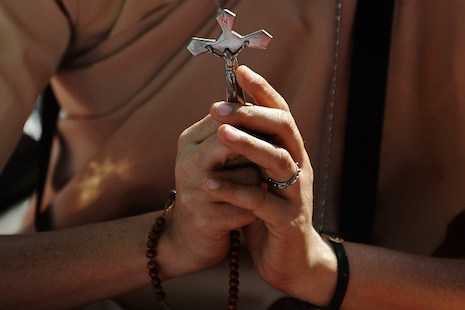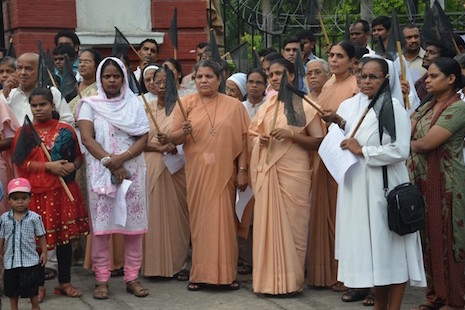
An Indian Catholic devotee holds a cross as she takes part in a protest in Mumbai on February 9, 2015. (AFP PHOTO/ PUNIT PARANJPE)
Pope Francis declared that 2015 would be an international Year of Consecrated Life. In a series of features, ucanews.com explores the status of religious life throughout the regions we cover. In our final installment, today's feature examines religious life in South Asia.
At 67, Brother Michael Mundanatt is the youngest of five friars in a Capuchin province spanning most of northern India.
He may well be the last.
Br Mundanatt lives with a dozen Capuchin priests in the headquarters of Krist Jyoti province on the outskirts of New Delhi. He says he is “not worried” about being the youngest brother.
But his provincial, Father P.A. Joseph, notes that the presence of brothers in several congregations in the region may well be nearing an end.
“In our province, we don’t have more joining us to be brothers,” he said.
As religious gathered this week in Thailand for a symposium hosted by the Federation of Asian Bishops’ Conferences, religious men and women throughout the region find themselves facing new challenges to their missions.
Like the Capuchin brothers, religious throughout South Asia are seeing significant transformations that will affect the future of consecrated life. In countries such as Bangladesh, India, Pakistan and Sri Lanka, the very complexion of religious congregations is changing.
“Fewer people now come from traditional Catholic pockets and more are coming from tribal and socially poor groups," Fr Joseph said of the situation in India.
Most new recruits joining India’s 125,000 religious men and women now come from areas where missionaries became active in the latter half of the 20th century, he said.
Only three decades ago, most of India's religious came from pockets of Kerala, Goa, Karnataka states and cities like Kolkata and Mumbai, where Catholic communities are centuries old.
This demographic shift is paralleled elsewhere in South Asia.
Decades ago in Bangladesh, for example, the majority of religious came from traditional Bengali Catholic families. Today, most come from indigenous families.
“The recruits from tribal communities are increasing and those from the Bengali group are declining,” said Father James Clement, president of the Conference of Religious in Bangladesh.
He estimates that men and women from indigenous communities now make up 60 percent of an estimated 1,225 religious in the Muslim-majority country. People from traditional Bengali Catholic families represent about 40 percent. It used to be the opposite in the past, he said.
In Pakistan, religious have traditionally been drawn from the ranks of the Goan Catholic community. Today, however, more people come from the Punjabi community, the country’s largest ethnic group, according to Kashif Anthony, a coordinator for the National Commission for Justice and Peace.
Anthony said large numbers of Goan Catholics have migrated from Pakistan, which has partially contributed to the demographic shift.
The origins of the Church in Pakistan were based around foreign missionaries. In the last decade, however, the number of foreign missionaries has dropped significantly, according to Father Pascal Paulus, president of the Major Religious Superiors Leadership Conference of Pakistan.
“Those who are present are slowly decreasing in number,” he said. “Government policies, terrorism and a decline in European vocations are to blame.”
He said recruiting local religious men and women is another challenge. The Dominican provincial blames materialism, media and smartphones for this.
“Maybe we have also forgotten our roots,” he said. “People are finding it hard to find an ideal religious life in us. We need to become people who are really committed to peace and dialogue.”
However, other Church officials say younger people are still drawn to consecrated life.
"In Pakistan, there is a gradual increase in the number of men and women who are embracing religious life over the last 10 years and particularly the number of young people joining religious life is on the rise," Father Asif John, rector of St Francis Xavier Seminary in Lahore, told ucanews.com.
According to the directory of the Catholic Church in Pakistan, there are 308 priests, including 122 from religious congregations. In addition, there are 46 religious brothers and more than 800 nuns.
Buddhist-majority Sri Lanka, meanwhile, has some 3,400 religious, the majority of them women, according to De La Salle Brother Loyala Fernando.

Nuns join a protest for Dalit rights in New Delhi in 2013. (Photo by Bijay Kumar Minj)
Education
Improved living standards and shrinking family sizes may be contributing to the dwindling number of recruits coming from traditional Christian areas, says Salesian Father Joe Mannath, national secretary of the Conference of Religious India.
“It is globally true. The number of recruits fall when families become smaller and economic standards go up,” he said, agreeing that more recruits in India are from tribal communities in the north and from Dalit (former untouchables) groups in the south.
These demographic changes have implications for the future of religious formation.
“Their intellectual and emotional capacities need development,” Capuchin Fr Joseph, the Krist Jyoti provincial, said of many new recruits. “They have problems with language and cultures. Generally, their poor quality is a major concern.”
Jesuit Father George Pattery, Provincial of South Asia, acknowledges that fewer recruits are emerging from traditional Catholic belts and more from indigenous communities. There are some 4,000 Jesuits across the region.
English is the medium of formation for most religious, but it remains at minimum the second language for many recruits. This may be a challenge, but it doesn’t mean it has to have an adverse effect.
Having more recruits from non-traditional backgrounds will give the Church a new identity in South Asia, he said. Nevertheless, the demographic shift does mean that the Church must adapt to recruits’ changing needs for education and training, he said.
A symbol of Christianity
While the demography of congregations is changing, the reasons that attract new recruits to religious life are not.
Fr Mannath says most people join religious congregations because of a desire to serve the poor and the sick, and because of the struggle for the rights of the underprivileged.
Across South Asia, religious continue to be the face of the Church because of the prominent presence of schools, medical facilities, vocational training and social service centers.
Many parts of the region struggle with poverty, illiteracy, corruption and malnutrition. As the estimated 20 million Catholics in the region form a small minority of the population, religious institutions and services become an important symbol of Christianity.
“At the social level, we are providing bandages to the whole civic body that is very sick,” Fr Mannath said.
For Capuchin brothers in India however, there is recognition of the coming changes.
Across the region in congregations that allow for both priests and brothers, there are fewer and fewer recruits to replace the aging friars, according to Capuchin Father Varghese Manimala, a spiritual theologian and expert in formation.
“The power and influence attached to priesthood, and lack of it in brotherhood, is plainly the reason for abandoning brotherhood,” he said.
Br Mundanatt, the 67-year-old friar, says that he can’t worry about who, if anyone, will take his place in the brotherhood.
For the present day, the brotherhood is his “chosen path.”
“I’m not worried if someone follows me on that tomorrow,” he said.
Additional reporting by Quintus Colombage in Colombo, Rock Ronald Rozario in Dhaka and ucanews.com reporters in Karachi and Lahore.


